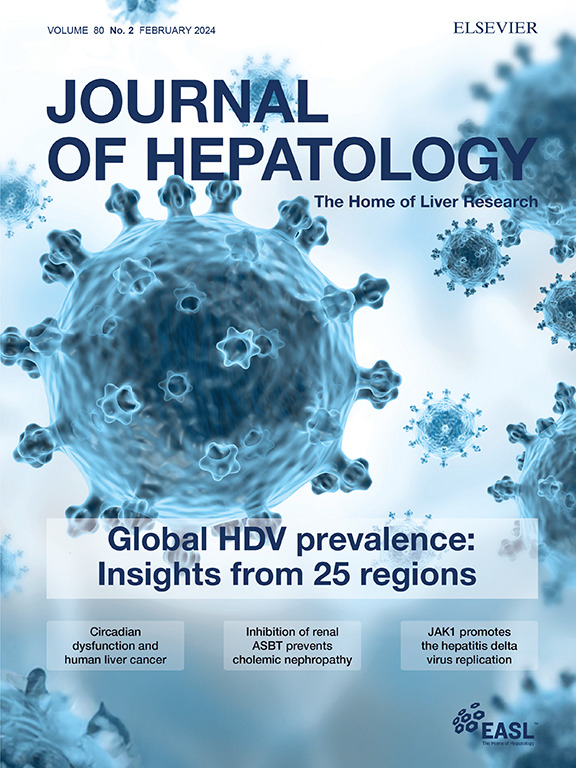HES V2.0 validation and performance compared to GALAD and ASAP in the HEDS cohort
IF 33
1区 医学
Q1 GASTROENTEROLOGY & HEPATOLOGY
引用次数: 0
Abstract
Background
We previously developed Hepatocellular Carcinoma Early Detection Screening (HES) V2.0, biomarker panel (age, ALT, platelets, etiology, AFP, AFP L3, DCP and their gradient over the past one year) for early detection of HCC among patients with cirrhosis. We externally validated HES V2.0 and compared its performance to HES V1.0, GALAD, and ASAP.Methods
We conducted a prospective-specimen collection, retrospective-blinded-evaluation (PRoBE) cohort study in the HEDS (Hepatocellular Carcinoma Early Detection Strategy) 1,485 cirrhosis cohort (119 developed HCC). Patient- and test-level true positive rate (TPR) for HCC were calculated at 6, 12, 24 months before HCC diagnosis based on a threshold at a fixed false positive rate (FPR) of 10% and 18.1% - the latter corresponded to GALAD cut-off of -1.36.Results
HES V2.0 and GALAD had same AUROC (0.79) but different TPR/FPRs. At the FPR of 10%, HES V2.0 had 2.0%, 6.7%, and 6.0% higher TPR (sensitivity) than GALAD within 6, 12, and 24 months before HCC diagnosis (one-sided p-values 0.24, 0.025, 0.078, respectively). At 18.1% FPR, GALAD had 6% and 2% higher sensitivity than HES V2.0 within 6 and 12 months before HCC and similar sensitivity within 24 months before HCC diagnosis (all p-values >0.05).The sensitivity for HES V2.0 was 11.9% higher than HES V1.0 at 12 months (p=0.007). The sensitivity for HES V2.0 was considerably (10.9-16.3%) higher than ASAP. For patients with available labs to calculate gradients over time, the sensitivity of HES V2.0 was 3.5-8.7% higher than GALAD at all time points of testing before HCC (8.7% to 24.0% relative increase) with p<0.05 for several comparisons.Conclusions
In a phase 3 biomarker validation study, HES V2.0 had higher sensitivity than ASAP for HCC detection, and a similar or higher sensitivity than GALAD only at 12 months before HCC diagnosis at 10% FPR and when over time gradients in AFP, AFP L3, and DCP are available.Impact and Implications
Hepatocellular carcinoma (HCC) remains a leading cause of cancer-related mortality, with early detection being critical for improving survival outcomes. This study provides a rigorous phase 3 validation of the HES V2.0 biomarker panel, demonstrating its superior or comparable sensitivity to established models like GALAD and ASAP in a large, diverse U.S. cirrhosis cohort. The findings are particularly impactful for clinicians and researchers focused on liver cancer surveillance, as HES V2.0 offers enhanced detection performance, especially when longitudinal biomarker data are available. These results support the integration of HES V2.0 into clinical workflows and future trials, potentially improving early HCC detection and enabling timely curative interventions for at-risk patients.

在HEDS队列中,与GALAD和ASAP相比,HES V2.0验证和性能
我们之前开发了肝细胞癌早期检测筛查(HES) V2.0,生物标志物面板(年龄,ALT,血小板,病因,AFP, AFP L3, DCP及其在过去一年内的梯度)用于肝硬化患者的HCC早期检测。我们对HES V2.0进行了外部验证,并将其性能与HES V1.0、GALAD和ASAP进行了比较。方法在HEDS(肝细胞癌早期检测策略)的1485例肝硬化队列(其中119例发生HCC)中进行前瞻性标本收集、回顾性盲法评估(PRoBE)队列研究。在HCC诊断前6、12、24个月,根据固定假阳性率(FPR) 10%和18.1%的阈值计算患者和测试水平的HCC真阳性率(TPR),后者对应于GALAD截止值-1.36。结果hsh2.0与GALAD的AUROC(0.79)相同,但TPR/ fpr有差异。在FPR为10%时,HES V2.0在HCC诊断前6、12、24个月内的TPR(敏感性)比GALAD高2.0%、6.7%、6.0%(单侧p值分别为0.24、0.025、0.078)。在18.1% FPR下,GALAD在HCC前6个月和12个月内的敏感性分别比HES V2.0高6%和2%,在HCC诊断前24个月内的敏感性相似(p值均为0.05)。在12个月时,HES V2.0的敏感性比HES V1.0高11.9% (p=0.007)。HES V2.0的灵敏度明显高于ASAP(10.9 ~ 16.3%)。对于有实验室计算随时间变化梯度的患者,在HCC前检测的所有时间点,HES V2.0的敏感性比GALAD高3.5-8.7%(相对增加8.7%至24.0%),几项比较的p<;0.05。结论在一项3期生物标志物验证研究中,HES V2.0对HCC的检测灵敏度高于ASAP,仅在HCC诊断前12个月,当FPR为10%时,当AFP、AFP L3和DCP随时间变化时,其灵敏度与GALAD相似或更高。影响和意义肝细胞癌(HCC)仍然是癌症相关死亡的主要原因,早期发现对于改善生存结果至关重要。该研究对HES V2.0生物标志物面板进行了严格的3期验证,在一个大型、多样化的美国肝硬化队列中,证明了其优于GALAD和ASAP等已建立模型或与之相当的敏感性。这些发现对专注于肝癌监测的临床医生和研究人员特别有影响,因为HES V2.0提供了增强的检测性能,特别是当纵向生物标志物数据可用时。这些结果支持将HES V2.0整合到临床工作流程和未来的试验中,有可能改善HCC的早期检测,并为高危患者提供及时的治疗干预。
本文章由计算机程序翻译,如有差异,请以英文原文为准。
求助全文
约1分钟内获得全文
求助全文
来源期刊

Journal of Hepatology
医学-胃肠肝病学
CiteScore
46.10
自引率
4.30%
发文量
2325
审稿时长
30 days
期刊介绍:
The Journal of Hepatology is the official publication of the European Association for the Study of the Liver (EASL). It is dedicated to presenting clinical and basic research in the field of hepatology through original papers, reviews, case reports, and letters to the Editor. The Journal is published in English and may consider supplements that pass an editorial review.
 求助内容:
求助内容: 应助结果提醒方式:
应助结果提醒方式:


